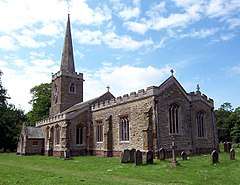Hainton
Hainton is a village and civil parish in the East Lindsey district of Lincolnshire, England. It is situated on the A157 road, 10 miles (16 km) west from Louth and 5 miles (8 km) south-east from Market Rasen.
| Hainton | |
|---|---|
 St Mary's Church, Hainton | |
 Hainton Location within Lincolnshire | |
| Population | 114 (2011)[1] |
| OS grid reference | TF183843 |
| • London | 125 mi (201 km) S |
| District | |
| Shire county | |
| Region | |
| Country | England |
| Sovereign state | United Kingdom |
| Post town | Market Rasen |
| Postcode district | LN8 |
| Police | Lincolnshire |
| Fire | Lincolnshire |
| Ambulance | East Midlands |
| UK Parliament | |
Hainton is listed in the 1086 Domesday Book as "Haintone", with 9 villagers, 2 smallholders, 1 freeman, and a 100 acres (0.4 km2) of meadow, and given over to Ilbert of Lacy as Lord of the Manor.[2]
The village is the site of a Medieval settlement, with evidence of earthworks indicating a ridge and furrow field system and crofts.[3]
In 1885 Kelly's Directory recorded a now listed school[4] built by G. F. Heneage in 1846. Agricultural production in the 2,306 acres (9.33 km2) acre parish was chiefly wheat, barley, oats and turnips.[5]
Church
Hainton Grade I listed Anglican church is dedicated to St Mary. A parish church originating in the 11th century, with changes in the 13th and refurbishment in the 14th, it was possibly re-modelled by Capability Brown in 1763.[6] It was restored by Edward James Willson in 1848 who retained early Norman lower stages of the tower and Early English nave arcades.[7][8]
Cox states: "The church (St Mary) is of much interest, especially for its monuments".[7] Monuments and effigies to the Heneage family date back to the 15th century, and are set within the north chapel off the chancel.[8]
The rectory at Hainton was once the home of the Tudor composer William Byrd; in 1562/3, the lease of the rectory was granted by the Dean and Chapter of Lincoln Cathedral to Byrd for a period of 41 years.[9]
Hainton Hall
Hainton Hall has been the seat of the Heneage family since the reign of Henry III.[7] It is set in a park of 145 acres (0.59 km2), landscaped by Capability Brown about 1763.[8] The present hall was built in 1638 with later additions,[10] and a rebuilding and raising of the west wing, and the facing of the whole house in stucco, by Peter Atkinson in 1809. A porch was added by William Burn in 1875.[8] Behind the south front are Georgian interiors. The main interior hall, of two-story height with staircase to an upper landing, has plasterwork in Rococo style. The Morning Room has ceiling patterns perhaps by James Gibbs.[8]
In 1838 Thomas Moule noted ancestral family portraits at the Hall, particularly one of Sir Thomas Heneage, Vice-Chamberlain of the Household and Chancellor of the Duchy of Lancaster to Queen Elizabeth.[11]
In the estate grounds is the Roman Catholic chapel of St Francis De Sales, now Grade II listed, designed by Willson.[12][13] Erected in 1836 by G. H. Heneage, it was dedicated to Heneage's late wife.[5]
The estate holds a listed 1807 stuccoed stable block,[14] perhaps the work of Atkinson, and several 1836 estate cottages, the work of William Danby.[8]
The Heneage family were raised to the Baronetcy in 1896.[15] In 1967, on the death of Thomas Robert Heneage, the title became extinct.[16]
Amenities
Hainton public house is the Heneage Arms.
References
- "Parish population 2011". Neighbourhood Statistics. Office for National Statistics. Retrieved 20 August 2015.
- Hainton in the Domesday Book. Retrieved 16 August 2011.
- Historic England. "Hainton (1050936)". PastScape. Retrieved 16 August 2011.
- Historic England. "School and Schoolmaster's House (1359970)". National Heritage List for England. Retrieved 16 August 2011.
- Kelly's Directory of Lincolnshire with the port of Hull 1885, pp. 463, 464
- Historic England. "Church of St Mary (1147298)". National Heritage List for England. Retrieved 16 August 2011.
- Cox, J. Charles (1916) Lincolnshire pp. 515, 152; Methuen & Co. Ltd
- Pevsner, Nikolaus; Harris, John; The Buildings of England: Lincolnshire pp. 262, 263; Penguin (1964); revised by Nicholas Antram in 1989, Yale University Press. ISBN 0-300-09620-8
- Harley, John. "Appendix C: William Byrd's Leases". The World of William Byrd: Musicians, Merchants and Magnates. Routledge. ISBN 9781317011477. Retrieved 3 September 2016.
- Historic England. "Hainton Hall (1063102)". National Heritage List for England. Retrieved 16 August 2011.
- Moule, Thomas; The english counties delineated, Volume 2, p. 216; London, George Virtue (1838). Retrieved 16 August 2011
- Waterhouse, Paul (1885–1900). . Dictionary of National Biography. London: Smith, Elder & Co.
- Historic England. "Chapel of St Francis De Sales (1308552)". National Heritage List for England. Retrieved 16 August 2011.
- Historic England. "Stable Block to Hainton Hall (1147323)". National Heritage List for England. Retrieved 16 August 2011.
- "No. 26747". The London Gazette. 9 June 1896. p. 3382. Retrieved 16 August 2011
- L. G. Pine (1972). The New Extinct Peerage 1884-1971: Containing Extinct, Abeyant, Dormant and Suspended Peerages With Genealogies and Arms. London: Heraldry Today. p. 146.
External links

- "Hainton", Genuki.org.uk. Retrieved 16 August 2011
- Hainton, Lincolnshire", A Vision of Britain Through Time. Retrieved 16 August 2011